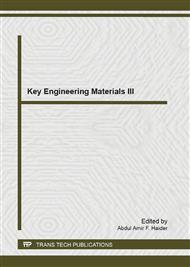p.42
p.47
p.53
p.59
p.64
p.71
p.77
p.82
p.87
Thermal Characterizations and Mechanical Properties of Hybrid Blends of Pva/Starch/LLDPE
Abstract:
Plastic resistance to be degraded by microbial activity has led to serious waste and landfill problems. Thus a study has been constructed to replace the non renewable and non degradable material with natural and synthetic biodegradable resources commonly available, namely Sago Starch and Polyvinyl alcohol (PVA). Hybrid blend consists of Sago Starch (SS), Polyvinyl Alcohol (PVA) and LLDPE has been developed and thermal and mechanical properties of this blend have been investigated. DSC plot for blend of various composition of PVA and SS formulated with fixed amount of LLDPE reported series of different gelation and melting temperature for SS and LLDPE. Tensile strength for all hybrid samples were found to have higher strength than pure SS blend, range from 4-6 Mpa compared to 1-2 Mpa. Modulus of Hybrid samples were range from 54.469 243.066. Increase the starch loading deceases the modulus of the blends. FTIR spectrums for all samples showed peaks at 3301 cm-1 -3322 cm-1 and 1462 cm-1 indicating that hydroxyl groups and CH2 bending vibration were presents in the blends.
Info:
Periodical:
Pages:
64-68
Citation:
Online since:
May 2013
Authors:
Price:
Сopyright:
© 2013 Trans Tech Publications Ltd. All Rights Reserved
Share:
Citation:


